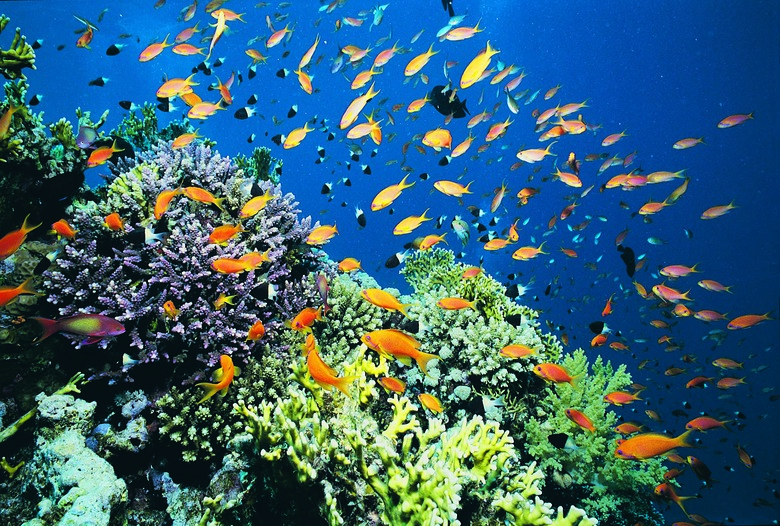Marine Ecosystem Classification
The term "ecosystem" refers to all of the non-living and living elements of a natural environment, including but not limited to water, sunlight, rock, sand, vegetation, microorganisms, bugs and wildlife. Marine ecosystems are aquatic ecosystems whose waters possess a high salt content. Out of all of the types of ecosystems on the planet, marine ecosystems are the most prevalent. They teem with life, providing nearly half of the Earth's oxygen and a home for a wide array of species. Scientists generally classify marine ecosystems into six main categories; however, labels aren't always clearly defined, so some categories may overlap or envelop other categories. Also, within each broad category, smaller specialized sub-categories may exist, for instance littoral zones and hydrothermal vents.
Open Marine Ecosystems
Open Marine Ecosystems
The first thing many people think of upon hearing the term "marine ecosystem" is the open ocean, which is indeed a major type of marine ecosystem. This category includes types of sea life that float or swim, such as algae, plankton, jellyfish and whales. Many creatures living in the open ocean inhabit the upper layer of the ocean where the sun's rays penetrate. This is known as the euphotic zone and extends to a depth of about 150 meters (500 feet).
Ocean Floor Ecosystems
Ocean Floor Ecosystems
Marine life not only exists in the open ocean waters, but on its floor as well. Species that live in this ecosystem include certain types of fish, crustaceans, clams, oysters, worms, urchins, seaweed and smaller organisms. In the shallow water, sunlight can penetrate to the bottom. However, at greater depths, sunlight cannot penetrate, and organisms inhabiting this deep water rely on the sinking of organic matter above for survival. Many such organisms are small and generate their own light to find or attract food sources.
Coral Reef Ecosystems
Coral Reef Ecosystems
Coral reefs are a special subtype of seafloor ecosystem. Found only in warm tropical waters and at relatively shallow depths, coral reefs are among the most productive ecosystems on the planet. About one-quarter of marine species depend on coral reefs for food, shelter or both. While coral reefs are famous for attracting brightly colored exotic fish, a plethora of other species — snails, sponges and seahorses, to name a few — inhabit coral reefs. The reefs themselves are produced by simple animals that build external skeletons around themselves.
Estuary Ecosystems
Estuary Ecosystems
The term "estuary" typically describes the shallow, sheltered area of a river mouth where freshwater intermingles with saltwater as it enters the sea, although the term can also refer to other areas with flowing brackish waters, such as lagoons or glades. The degree of salinity varies with the tides and the volume of outflow from the river. The organisms inhabiting estuaries are specially adapted to these distinct conditions; hence, the diversity of species tends to be lower than in the open ocean. However, species which generally inhabit neighboring ecosystems may occasionally be found in estuaries. Estuaries also serve an important function as nurseries for many types of fish and shrimp.
Saltwater Wetland Estuary Ecosystems
Saltwater Wetland Estuary Ecosystems
Found in coastal areas, saltwater wetlands may be considered a special type of estuary, as they also consist of a transition zone between land and sea. These wetlands can be divided into two categories: saltwater swamps and salt marshes. Swamps and marshes differ in that the former are dominated by trees while the latter are dominated by grasses or reeds. Fish, shellfish, amphibians, reptiles and birds may live in or seasonally migrate to wetlands. Additionally, wetlands serve as a protective barrier to inland ecosystems, as they provide a buffer from storm surges.
Mangrove Ecosystems
Mangrove Ecosystems
Some tropical and subtropical coastal areas are home to special types of saltwater swamps known as mangroves. Mangroves may be considered part of shoreline ecosystems or estuary ecosystems. Mangrove swamps are characterized by trees that tolerate a saline environment, whose roots systems extend above the water line to obtain oxygen, presenting a mazelike web. Mangroves host a wide diversity of life, including sponges, shrimp, crabs, jellyfish, fish, birds and even crocodiles.
References
Cite This Article
MLA
Harris, Amy. "Marine Ecosystem Classification" sciencing.com, https://www.sciencing.com/marine-ecosystem-classification-38170/. 6 August 2018.
APA
Harris, Amy. (2018, August 6). Marine Ecosystem Classification. sciencing.com. Retrieved from https://www.sciencing.com/marine-ecosystem-classification-38170/
Chicago
Harris, Amy. Marine Ecosystem Classification last modified August 30, 2022. https://www.sciencing.com/marine-ecosystem-classification-38170/
